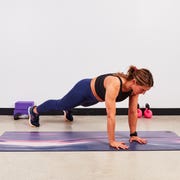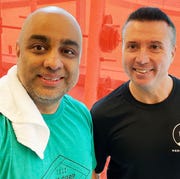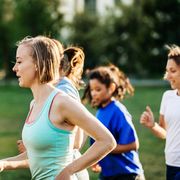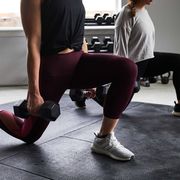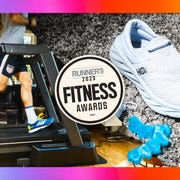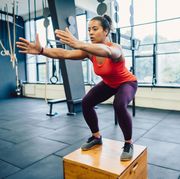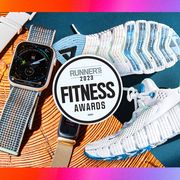Sore glutes can be a pain in the butt, but if you want relief, you might just have to get moving: Performing exercises A Part of Hearst Digital Media may be the best approach to dealing with gluteal tendinopathy, a painful tendinitis of the soft tissue over the side of your hip, according to new research out of Australia.
In the study, researchers divided just more than 200 people with long-term lateral hip pain into three treatment groups: those receiving a cortisone shot; those immediately starting a strength training program, comprised of exercises like bridges, single-leg squats, and step-ups; and those taking a wait-and-see approach (i.e., doing nothing and hoping for the best).
After eight weeks, those in the shot group and strengthening group were doing much better than the wait-and-see group, as measured by their overall assessment of improvement and severity of pain. At the beginning of the study, the average pain rating for all participants on a scale of 1 to 10 was a 5.
More From Runner's World

After eight weeks of exercise and education, the strengthening group rated their pain as 1.5 on the same scale, the cortisone group said their pain was down to 2.7, while the rest group said they were at 3.7.
One year later, the exercise group still reported less severe pain (2.1 on the scale) than the shot group (2.3) and rest group (3.2). The biggest difference a year later was that about 80 percent of the exercise group said their hip condition was doing at least moderately better, while less than 60 percent of the other two groups reported that level of improvement.
It’s interesting to note that, after eight weeks, the exercise group performed the same as other groups on tests of leg muscle strength. The researchers speculate that the education portion of this group’s program—advice on matters such as good posture and how to safely make the exercises more challenging—could contribute to the difference. Also, over time, the exercises may have improved tendon strength and, by improving pelvic stability, allowed better movement patterns.
Although the subjects in this study weren’t runners, one of the researchers, Alison Grimaldi, Ph.D., said in an email to Runner’s World that she uses a similar exercise program when treating runners with lateral hip pain. Grimaldi offered these running-specific tips when dealing with this condition:
- Shorten your stride and increase your cadence. Lower cadence results in higher loads on the hip when you land.
- Minimize hill running when sore, and avoid hill running on consecutive days while you still have pain
- Adjust your distance and speed as needed so that your hip pain doesn’t worsen during runs. If you have increased pain later in the day, your run was too far and/or fast.
The gluteal tendinopathy in this study’s subjects was determined by diagnostic testing. But, said Grimaldi, the exercises they used, like bridges, single-leg squats, and step-ups, should help anyone with non-bone pain in the area, too, whether it’s due to issues with the gluteal tendons, bursae, or iliotibial band.

Scott is a veteran running, fitness, and health journalist who has held senior editorial positions at Runner’s World and Running Times. Much of his writing translates sport science research and elite best practices into practical guidance for everyday athletes. He is the author or coauthor of several running books, including Age Grade Calculator, Advanced Marathoning, and Strength Training Eases Glute Pain. Trail Running Gear Slate, The Atlantic, the Washington Post, and other members of the sedentary media. His lifetime running odometer is past 110,000 miles, but he’s as much in love as ever.

